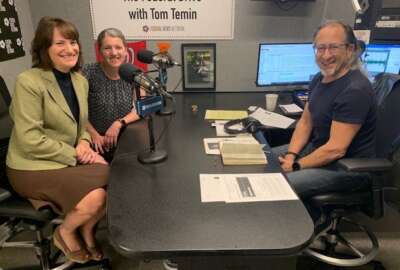This FDA scientist’s work helps public health officials find sources of tainted food faster
Steven Musser, deputy director for Scientific Operations in the FDA's Center for Food Safety and Applied Nutrition, developed the application of a methodology...
Best listening experience is on Chrome, Firefox or Safari. Subscribe to Federal Drive’s daily audio interviews on Apple Podcasts or PodcastOne.
When people get some sort of foodborne illness, you want the source off the market as soon as possible. At one time that took weeks or even months. Steven Musser, deputy director for Scientific Operations in the FDA’s Center for Food Safety and Applied Nutrition, developed the application of a methodology called genomic epidemiology. To foodborne heebie jeebies, it greatly speeds up pinpointing the source. For his work, he’s a finalist in this year’s Service to America Medals program, and he joined the Federal Drive with Tom Temin to talk more.
Interview transcript:
Tom Temin: Dr. Musser. Good to have you with us.
Steven Musser: Thanks, Tom, thanks for the opportunity to talk about this.
Tom Temin: And COVID has in the last few years kind of wiped everything else off of the public consciousness. But foodborne illness is pretty nasty. Give us a sense of how widespread it still is and what some of the effects can be.
Steven Musser: I’ll just give you some estimates from the CDC: They estimate that about 48 million, almost 58 million people in the United States get foodborne illness every year. About 128,000 are hospitalized and 3,000 die. These are estimates, of course. Might also be helpful to put it in economic terms: The economic burden of foodborne illness is about $18 billion annually.
Tom Temin: So it’s a bad problem one way or the other. And I want to get right to your work, which is genomic epidemiology. What is that?
Steven Musser: Well, if you imagine the technology that’s used if you’ve ever heard about prisoners being released based on their DNA, because they were improperly accused, or the evidence was, new evidence has come forward based on genomic information, it’s the same type of approach except we’re looking at the bacterias DNA fingerprint instead of a human’s bacterium. And we match them up. And we can say, Yes, the same one is found in a food that’s found in someone that got sick. So we basically have a very specific and sensitive method for looking and comparing what people got sick from and how they got sick and where it’s linked, which is something that’s new, and we didn’t have before. In the past, we basically had an approach that looked at people that got sick, and it was low resolution. So we knew people got sick, but we didn’t know how they got sick or where they got sick from. It was a good technology at the time. But this is a much better system. It’s much more sensitive and much more easy to link illness with human disease.
Tom Temin: And just a detail question here, someone is sick and it appears to have the symptoms of what we understand to be foodborne. How do you obtain the bacteria samples that might be relevant that are in that person?
Steven Musser: Really good question. So we work with CDC and other federal partners. CDC does the clinical illness, they fund public health across the nation in every state and in many of the big cities. And if someone gets sick with a reportable disease like salmonella, or E. coli, the public health system there will pick that up from the person, the doctor will give them a culture, they’ll isolate the bacteria. They’ll sequence it and upload it into the central database, which is at NIH at NCBI. And then we and FSIS do something very similar. FSIS does the meat and poultry part of this. We do surveillance, we pick up samples from imports during inspections. Thousands and thousands every year, and we isolate the bacteria from those samples and upload them into the same database. And so the way this works is we have some very sophisticated computer algorithms that look through these data. And every day tell us whether we do or don’t have matches, well matches in the sense that they’re related to each other. And this really helps us pinpoint disease in ways that we couldn’t do it any other way before.
Tom Temin: And just one more detailed question. We know that now that foodborne illness comes from a variety of types of foods. So is the bacteria profile that might be in chicken kind of unique to chicken versus what might be in turnips, which is different from what might be in arugula, for example?
Steven Musser: Surprisingly not. So if you had salmonella, we’ve done a huge study to kind of answer this question on the Eastern Shore of Maryland, Delmarva Peninsula. And we looked at there was a very famous salmonella type there. And it had a specific pattern from CDC every year, it made people sick. And we looked at where we could find that and we found it in chickens, we found it in the water, we found it on produce. So it’s exactly the same. It just depends on whether you’re being careful with your processing of chicken or you’re being careful with the water you use when you’re irrigating crops, or when you harvest the crops are you being careful with the way you harvest them and pack them and ship them. So you can have the same bacteria just –
Tom Temin: Sure. We’re speaking with Dr. Steven Musser, he’s deputy director for Scientific Operations in the FDA Center for Food Safety and Applied Nutrition, and a finalist in this year’s Service to America Medals program. And knowing these profiles and being able to match them. How does that translate operationally so that local authorities that detect this thing in the CDC involvement, so the food that might be contaminated is found and taken off the market quickly?
Steven Musser: Sounds easy, but it’s pretty complicated. There’s two ways to do this. For example, let’s say we did an inspection of a plant. And there were no illnesses associated with any of the products, but we found a pathogen outside the plant or not on a food contact surface, we would sequence it and upload it. And then sometime later, let’s say there’s some bad conditions at the plant that could be weather related, just change in management, anything, and we start to see illnesses. So in the past, we couldn’t intervene. Now we can intervene immediately. We know exactly because the sensitivity and specificity is so good, we know exactly where to look. And we can go back to that plan and see if they have a problem, and have that product removed very quickly.
So that’s called retrospective. What happens most of the time, and that is we start to see illnesses. CDC starts to see the same people getting sick from exactly the same genetic organism, and they start to look at well, was it from a food? Is it from a, something where they might have gotten sick. And this used to be, still very complicated. If you imagine eating a salad, you got lettuce, you got tomatoes, you got croutons, you got spices, you got, you could have 50 ingredients in there. And you asked someone, did you have a salad? And they say, Yes. And what did the salad have on it? They might remember tomatoes or lettuce.
But with the genetic information, now we can say and help these epidemiology investigations and say, well, it’s likely from the southeastern part of the United States, or the southwestern, or this looks like something we imported from Southeast Asia. Or we’ve seen this before in Spain from imports. And so we can take those 50 component lettuce mixtures and break it down quickly and say what’s most likely this ingredient, or most likely, from this area, which speeds the way we do investigations. And if we look at the last 10 years, since we’ve implemented genome tracker, what we see is that we detect more outbreaks, because we have more sensitivity, but we also intervene faster. So instead of having 700,000-800,000 people sick we have fewer, 10, 20, 30. So we’ve really impacted not so much the number of outbreaks, but the number of people that get sick from that, using this technology
Tom Temin: Over time, the more that you get into the genome tracker database of bacteria, the better the system will work. It sounds like it’s self improving on a continuous basis.
Steven Musser: Yeah, that was one of the things that attracted us to it. Interestingly enough, we had been looking for this since the mid 2000s, we had a number of important outbreaks. And we were trying to find a way to more quickly get into this. And we tried lots, many, dozens of different approaches. And when we arrived at this one, I remember looking at the data and going, Oh, my, this is going to work. And this is going to work for a very long time because you don’t have to repeat it. You don’t have to develop a new database, you can add to it itself, kind of self correcting in that if you get something a sequence that’s wrong, it automatically shows up. The technology was remarkably easy to use. We’ve, we’ve trained about all 50 states, as well as some other states, international governments, and in all cases, usually within a week of receiving the instruments and training, people are uploading sequences into the database without any trouble whatsoever. So it’s been a remarkable journey and watching it grow.
Tom Temin: And this has really been a long-term journey. I can remember the Vichyssoise bacteria scandal, I think that was in the late 1960s. And people started to become aware of this canned potato soup that you didn’t heat up and it was poisoning people. I don’t know how long ago that was. But just briefly, what is your background? How did you come to this type of work and end up at the FDA?
Steven Musser: Kind of through a long circuitous route. I’ve been here, I’ll be celebrating my 31st anniversary as an FDA employee this August. I came here I was a post doc at NIH. My background is medicinal chemistry. I make and synthesize new drugs and evaluate them, particularly my specialty was in cancer research. I was recruited by FDA to do analytical chemistry and work on variety of food things. I thought I would stay for a little while and leave and look at a drug manufacturer and I really loved it. The work was was very interesting. There was always something going on. And food people are really interested in their food and the quality of their food. And so I started as a bench chemist, and 31 years later, I ended up as deputy center director. Been in this position for about seven years and have to look at all things safety, not just bacteria, but viruses, chemicals, cosmetics, premarket issues, just a whole range of things. And I love it. It’s just a great job to have.
Tom Temin: And do you ever still get close to a Bunsen burner and a flask anymore?
Steven Musser: Well, I think most of the laboratory people now take great care when I do laboratory visits to not let me touch anything. Let me hold that for you, let me get that for you – don’t touch that! That kind of thing. So no, I don’t get to, I get to look at it but I don’t get to touch it anymore.
Tom Temin: Dr. Steven Musser is deputy director for Scientific Operations in the FDA Center for Food Safety and Applied Nutrition. Thanks so much forers joining me.
Steven Musser: Thank you, Tom.
Copyright © 2025 Federal News Network. All rights reserved. This website is not intended for users located within the European Economic Area.
Tom Temin is host of the Federal Drive and has been providing insight on federal technology and management issues for more than 30 years.
Follow @tteminWFED






